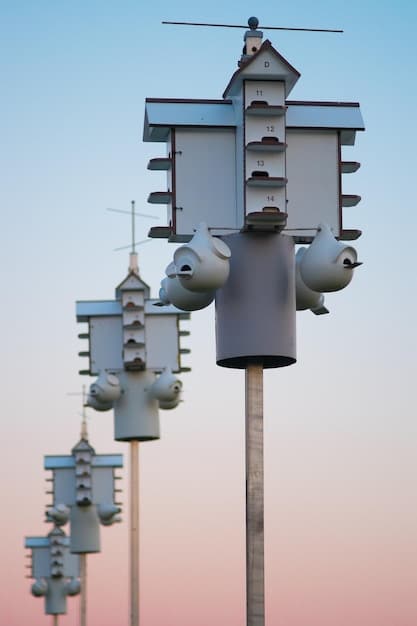Smart Grids in the US: AI Optimizes Energy & Cuts Outages

Smart grids in the US are being revolutionized by AI and data analytics, leading to optimized energy distribution and a significant 12% reduction in power outages through predictive maintenance and real-time adjustments.
The American power grid is undergoing a significant transformation, and at the heart of this evolution are smart grids in the US: how AI and data analytics are optimizing energy distribution and reducing outages by 12%. This innovative approach is not just about upgrading infrastructure; it’s about leveraging the power of artificial intelligence and data to create a more resilient, efficient, and sustainable energy ecosystem.
The Evolution of Smart Grids in the US
Smart grids represent a significant upgrade from traditional power grids, incorporating digital technology to improve efficiency, reliability, and sustainability. This transformation is crucial for meeting the growing energy demands of the US while addressing climate change concerns and enhancing grid security.
The journey towards smart grids has been gradual, marked by key technological advancements and policy initiatives. Early efforts focused on deploying smart meters and automating grid operations. Today, the emphasis is on integrating renewable energy sources, enhancing grid resilience, and empowering consumers with more control over their energy consumption.
Key Features of Smart Grids
Smart grids are distinguished by several key features that differentiate them from traditional grids. These features include advanced metering infrastructure (AMI), digital communication networks, and sophisticated control systems.
- Advanced Metering Infrastructure (AMI): AMI provides real-time data on energy consumption, enabling utilities to optimize energy delivery and detect outages more quickly.
- Digital Communication Networks: These networks facilitate seamless communication between grid components, allowing for real-time monitoring and control.
- Sophisticated Control Systems: These systems use algorithms and data analytics to optimize grid operations, predict potential problems, and respond to changing conditions.
- Integration of Renewable Energy Sources: Smart grids enable the seamless integration of solar, wind, and other renewable energy sources, promoting a more sustainable energy mix.
The evolution of smart grids in the US is driven by the need for a more resilient, efficient, and sustainable energy infrastructure. By embracing digital technology and data analytics, smart grids are paving the way for a cleaner and more reliable energy future.
The Role of AI in Optimizing Energy Distribution
Artificial intelligence (AI) is playing a pivotal role in optimizing energy distribution within smart grids. AI algorithms can analyze vast amounts of data to identify patterns, predict energy demand, and optimize grid operations in real-time.
The application of AI in energy distribution is not limited to just one area. It spans across various functions, including load forecasting, grid optimization, and predictive maintenance. This holistic approach ensures that the grid operates at peak efficiency and reliability.

AI-Powered Load Forecasting
Accurate load forecasting is essential for efficient energy distribution. AI algorithms can analyze historical data, weather patterns, and other relevant factors to predict energy demand with high accuracy.
By accurately forecasting energy demand, utilities can optimize energy generation and distribution, reducing waste and minimizing costs. This is particularly important with the increasing integration of intermittent renewable energy sources like solar and wind.
AI-Driven Grid Optimization
AI algorithms can optimize grid operations by dynamically adjusting energy flows based on real-time conditions. This ensures that energy is delivered efficiently and reliably to meet changing demand.
AI can also identify and mitigate potential grid congestion, preventing outages and improving overall grid stability. This is particularly important in urban areas with high energy demand and complex grid infrastructure.
AI is a game-changer in optimizing energy distribution within smart grids. By leveraging AI’s analytical capabilities, utilities can improve efficiency, reduce costs, and enhance grid reliability.
Data Analytics: The Backbone of Smart Grid Efficiency
Data analytics is the backbone of smart grid efficiency, providing valuable insights into grid operations and consumer behavior. By analyzing large datasets, utilities can identify opportunities to improve efficiency, reduce costs, and enhance reliability.
The benefits of data analytics in smart grids are multifaceted. It enables utilities to make data-driven decisions, optimize grid operations, and provide better services to consumers.
- Predictive Maintenance: Data analytics can identify potential equipment failures before they occur, enabling utilities to perform proactive maintenance and prevent outages.
- Demand Response Programs: By analyzing consumer energy consumption patterns, utilities can design effective demand response programs that incentivize consumers to reduce their energy consumption during peak periods.
- Energy Theft Detection: Data analytics can detect anomalies in energy consumption patterns, helping utilities identify and prevent energy theft.
Data analytics is crucial for unlocking the full potential of smart grids. By leveraging data-driven insights, utilities can optimize grid operations, reduce costs, and enhance the reliability and sustainability of the energy system.
Reducing Outages by 12%: A Data-Driven Approach
The implementation of smart grids, coupled with AI and data analytics, has led to a significant 12% reduction in power outages in the US. This reduction is a testament to the effectiveness of data-driven approaches in improving grid reliability.
The reduction in outages is attributed to several factors, including improved outage detection, predictive maintenance, and enhanced grid resilience. These improvements are made possible by the real-time data and analytical capabilities of smart grids.

Smart Grid Outage Detection
Smart grids can detect outages more quickly and accurately than traditional grids. Advanced metering infrastructure (AMI) provides real-time data on energy consumption, enabling utilities to identify outages within minutes.
Automated outage detection systems can automatically reroute power to restore service to affected areas, minimizing the duration of outages. This is particularly important during severe weather events when outages can affect a large number of customers.
Predictive Maintenance and Grid Resilience
Predictive maintenance is another key factor in reducing outages. By analyzing data on equipment performance, utilities can identify potential equipment failures before they occur.
This allows them to perform proactive maintenance, preventing outages and extending the lifespan of grid equipment. This is essential for maintaining grid reliability and reducing the risk of widespread outages.
The 12% reduction in power outages is a significant achievement, demonstrating the effectiveness of smart grids, AI, and data analytics in enhancing grid reliability. As smart grid technology continues to advance, we can expect even greater reductions in outages in the future.
Challenges and Opportunities in Smart Grid Implementation
While smart grids offer numerous benefits, their implementation is not without challenges. Overcoming these challenges is essential for realizing the full potential of smart grids in the US.
The challenges include high upfront costs, cybersecurity concerns, and regulatory hurdles. However, addressing these challenges presents significant opportunities for innovation and growth.
Addressing Cybersecurity Concerns
Cybersecurity is a major concern for smart grids due to their reliance on digital technology and communication networks. Protecting the grid from cyberattacks is crucial for maintaining its reliability and security.
Utilities must implement robust cybersecurity measures, including encryption, firewalls, and intrusion detection systems, to protect the grid from cyber threats. Collaboration between utilities, government agencies, and cybersecurity experts is essential for staying ahead of evolving cyber threats.
Navigating Regulatory Hurdles
Smart grid implementation is also subject to various regulatory hurdles, including interconnection standards, data privacy regulations, and cost recovery mechanisms.
Streamlining regulatory processes and providing clear guidance can facilitate smart grid deployment and encourage innovation. Collaboration between utilities, regulators, and policymakers is essential for creating a supportive regulatory environment for smart grids.
Despite the challenges, the opportunities for smart grid implementation are vast. By addressing cybersecurity concerns, navigating regulatory hurdles, and fostering innovation, the US can unlock the full potential of smart grids and create a more resilient, efficient, and sustainable energy future.
The Future of Smart Grids: Trends and Innovations
The future of smart grids is bright, with numerous trends and innovations poised to transform the energy landscape. These trends include the integration of advanced technologies, the development of microgrids, and the advancement of consumer engagement strategies.
These innovations will further enhance grid reliability, efficiency, and sustainability, paving the way for a cleaner and more resilient energy future.
- Advanced Technologies: Technologies such as blockchain, edge computing, and quantum computing are poised to play a significant role in the future of smart grids.
- Microgrids: Microgrids are self-contained energy systems that can operate independently or in conjunction with the main grid, providing enhanced resilience and reliability.
- Consumer Engagement: Engaging consumers and empowering them with more control over their energy consumption is essential for the success of smart grids.
The future of smart grids is characterized by continuous innovation and technological advancement. By embracing these trends and investing in research and development, the US can maintain its leadership in smart grid technology and create a more sustainable and resilient energy future.
| Key Point | Brief Description |
|---|---|
| 💡 AI Optimization | AI algorithms optimize energy distribution in real-time. |
| 📊 Data Analytics | Data analytics offers insights into grid operations and consumer behavior. |
| ⚡ Outage Reduction | Smart grids contribute to a 12% reduction in power outages. |
| 🛡️ Cybersecurity | Addressing cybersecurity is vital for robust smart grid operation. |
Frequently Asked Questions
▼
A smart grid is an advanced electrical grid that uses digital technology to improve efficiency, reliability, and sustainability, enabling real-time monitoring and control of energy flow.
▼
AI algorithms analyze vast amounts of data to forecast energy demand, optimize grid operations, and predict potential problems, ensuring efficient and reliable energy delivery.
▼
Data analytics provides valuable insights into grid operations and consumer behavior, enabling utilities to make data-driven decisions, optimize grid efficiency, and enhance service quality.
▼
Smart grids improve outage detection, enable predictive maintenance, and enhance grid resilience through real-time data and automated rerouting, reducing the frequency and duration of power interruptions.
▼
Future trends include the integration of blockchain, edge computing, and advanced microgrids, alongside enhanced consumer engagement, to optimize energy systems further and promote sustainability.
Conclusion
In conclusion, the deployment of smart grids in the US, enhanced by AI and data analytics, signifies a monumental shift towards a more sustainable and efficient energy future. The observed 12% reduction in power outages is just a glimpse of the potential benefits, underscoring the importance of continued investment, innovation, and collaboration in this transformative technology.





